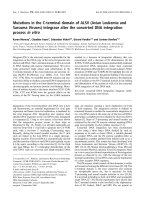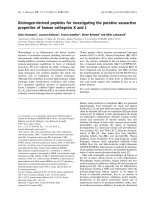THE LUXURY CONSUMER CLASSES OF INDIA CONSPICUOUSNESS, EMULATION AND DISTINCTION
Bạn đang xem bản rút gọn của tài liệu. Xem và tải ngay bản đầy đủ của tài liệu tại đây (1.13 MB, 109 trang )
THE LUXURY CONSUMER-CLASSES OF INDIA:
CONSPICUOUSNESS, EMULATION AND DISTINCTION
PRASHANT SAXENA
(MBA, Indian Institute of Technology Madras)
A THESIS SUBMITTED
FOR THE DEGREE OF MASTER OF SCIENCE
(BUSINESS)
DEPARTMENT OF MARKETING
NATIONAL UNIVERSITY OF SINGAPORE
2012
DECLARATION PAGE
I hereby declare that this thesis is my original work and it has been written by me in its
entirety. I have duly acknowledged all the sources of information which have been used
in the thesis.
This thesis has also not been submitted for any degree in any university previously.
_______________________________________
Prashant Saxena
14 August 2012
II
ACKNOWLEDGEMENTS
I am extremely grateful to the following individuals for helping me throughout the
journey of writing this thesis.
Senior Lecturer, Siok Kuan Tambyah
For believing in my potential and providing me with the wonderful opportunity to work
on this project. For the constructive feedback and being a source of inspiration.
Department of Marketing
For constant support and pushing me to become uncompromising in quality. I am deeply
indebted to the department for bringing out the researcher in me.
My friends
Thank you Smrithi for being a constant support during the course of this journey. Thank
you Vasugi for motivating me at various stages of this research.
My parents and sister
For all the love, care and patience. Words aren’t just enough.
To the Almighty
“The power of God is with you at all times; through the activities of mind, senses,
breathing, and emotions; and is constantly doing all the work using you as a mere
instrument.” – Bhagavad Gita
III
TABLE OF CONTENTS
SUMMARY ................................................................................................................. 1
LIST OF TABLES ........................................................................................................... 4
CHAPTER 1: INTRODUCTION ....................................................................................... 5
CHAPTER 2: LITERATURE OVERVIEW ........................................................................... 9
2.1 Veblen’s Theory of Conspicuousness
2.1.1 Veblen’s Theory of Conspicuous Consumption: Motivations and Drivers
2.1.2 Veblen’s Theory of Conspicuous Consumption: Criticisms and Research Gaps
2.2 Bourdieu’s Theory of Distinction
2.2.1 Bourdieu’s Theory of Distinction: Motivations and Drivers
2.2.2 Bourdieu’s Theory of Distinction: Criticisms and Research Gaps
2.3 Bourdieu’s Lifestyle Classification Model
10
12
15
18
20
22
23
CHAPTER 3: RESEARCH CONTEXT .............................................................................. 25
3.1 Indian Luxury Market Overview
3.2 The Luxurious Past: Religion and Epics of India
3.3 Robbed Luxury: Caste System, Indian Independence and Rise of Consumerism
3.4 Introducing the New Indian Consumer Classes
3.5 Research Questions
27
29
30
31
36
CHAPTER 4: RESEARCH METHODOLOGY.................................................................... 38
4.1 Qualitative Approach
4.2 Recruitment and Interview Procedure
4.3 Data Interpretation
38
39
43
CHAPTER 5: DATA ANALYSIS AND INTERPRETATION ................................................. 45
5.1 Consumer Class: Old Money
5.1.1 Meanings of Luxury
5.1.2 Conspicuousness
5.1.3 Emulation
5.1.4 Distinction
5.2 Consumer Class: New Money
5.2.1 Meanings of luxury
5.2.2 Conspicuousness
5.2.3 Emulation
5.2.4 Distinction
5.3 Consumer Class: Gold Collars
5.3.1 Meanings of luxury
5.3.2 Conspicuousness
5.3.3 Emulation
5.3.4 Distinction
5.4 Consumer Class: The BPO Generation
5.4.1 Meanings of luxury
5.4.2 Conspicuousness and Emulation
5.4.3 Distinction
47
47
49
52
54
58
58
60
62
64
65
65
67
68
69
70
71
73
74
CHAPTER 6: DISCUSSION AND IMPLICATIONS ........................................................... 76
IV
6.1 Research Findings
6.1.1 Meanings of Luxury
6.1.2 Conspicuousness
6.1.3 Emulation
6.1.4 Distinction
6.2 Theoretical Contribution and Managerial Implications
6.3 Limitations and Future Research
76
78
79
80
81
83
86
BIBLIOGRAPHY ......................................................................................................... 88
APPENDIX A: Participant Information Sheet And Consent Form ................................ 96
APPENDIX B: Interview Guide ................................................................................. 100
1
SUMMARY
Luxury consumption has often been studied at an individual level from exclusivity,
prestige, and self-identification perspectives. However, at a socio-economic class level,
the two prominent theories of status consumption are Veblen’s theory of conspicuous
consumption and Bourdieu’s theory of distinction. Veblen (1899) used the concept of
economic capital to highlight that luxury invokes conspicuousness and this
subsequently drives emulation behaviours, while Bourdieu (1984) extended this
argument by stating that luxury is used to mark distinctive identities by using cultural
capital.
Veblen’s theory of conspicuous consumption and Bourdieu’s theory of distinction
provided important insights into status consumption in western societies but they were
also criticized for their limited application to societies with uniform and static social
stratifications. Therefore, researchers called for more research into status consumption in
emerging economies where economic capital and cultural capital are non-uniformly
distributed. Due to the distinct differences in cultural and economic capital between the
different Indian consumer classes, India, a prominent emerging market for luxury
products, provides a very interesting and varied platform to study the class-based theories
of conspicuousness and distinction. The Indian consumer class structure is divided into
four major consumer classes; that is, the Old Money, Gold Collars, New Money and BPO
(Business Process Outsourcing) Generation (based on their possession of economic and
cultural capital).
2
For the Old Money, luxury is observed as a way of life and is born out of their
habitus. In terms of conspicuousness, the Old Money demonstrates both ostentation and
subtlety. Being the pioneers of luxury, the Old Money usually emulates those within their
own luxury category. They use objectified and embodied cultural capital to maintain
distinction with respect to the lower-status classes.
The New Money uses luxury brand products to signal their status and make them
socially conform to their Old Money clients. They are very conscious of its need to tell
the world of its arrival into the luxury market, and therefore are highly ostentatious in
their consumption choices and extremely distinctive with respect to the New Money from
the rural areas and the BPO generation
The Gold Collars believe in celebrating success while using quality and the
rationale of value for money to justify their spending on luxury products. They tend to
exhibit their conspicuousness very subtly. Their luxury consumption behaviour
demonstrates their reservoir of cultural capital that is mainly due to the high level of
education that they have obtained. They are non-specific in their emulation patterns and
tend to adopt anything that suits their aesthetic taste.
The BPO Generation believe in rationalizing their luxury purchases with the idea
of it being ‘worth it’ and to express their individuality. Their purchases are usually
moderately ostentatious and act as a means to signal their uniqueness. They emulate
popular celebrities and idols.
While adding another dimension to Veblen’s theory of conspicuousness and
Bourdieu’s theory of distinction, this research examines the psychological motivations
3
and the sources of capital adopted by the different luxury classes in India to demonstrate
their various inter- class behaviours such as conspicuousness, emulation and distinction.
4
LIST OF TABLES
Table 1. Bourdieu’s Lifestyle Classification Model ..................................................... 24
Table 2. The Lifestyle Classification Model in the Indian Context ............................... 32
Table 3. Lifestyle Categories in the Indian Context, Meanings of luxury,
Conspicuousness, Emulation and Distinction ............................................................ 77
5
CHAPTER 1: INTRODUCTION
The concept of luxury evokes multiple meanings. Some consumers hold luxury very
closely to themselves as it represents their identity. For others it could be perceived as
being an irrational expenditure. Extant research in marketing has incorporated these
several lenses to study individual-level luxury consumption from the varied perspectives
of identity (Belk 1988), prestige (Vigneron and Johnson 1999) and exclusivity (Phau
and Prendergast 2000). At a societal level, the desire for luxury manifests itself as status
consumption among various classes. Status consumption is often used as a tool to
negotiate the social class position (Üstüner and Thompson 2012; Üstüner and Holt
2010; Bourdieu 1984; Lamont 1992; Veblen 1899/1979).
To study these inter-class differences that drive luxury-seeking behaviours, the
theories of status consumption were developed to provide some perspectives on how and
why consumption patterns vary across an array of consumer groups. Veblen’s theory of
conscious consumption (1899/1979) highlighted the role of economic status and how it
drove conspicuousness and emulation patterns. The theory explained the inter-class
conspicuousness and emulations among the bourgeois and nouveau riche in European
society. It also identified various motivations such as signalling for status, social
conformity, uniqueness, habitus and culture. The nature of the capital leveraged in such
inter-class conspicuous consumption behaviours was economic in nature.
As an extension to this theory from a cultural perspective, Bourdieu’s theory of
distinction explicated the role of culture and its influence on distinction behaviours.
According to Bourdieu (1984), cultural capital played an important role in helping certain
sections of the bourgeois to maintain their distinction from the nouveau riche. Cultural
6
capital was divided into three subtypes: objectified, embodied and institutionalized
(Bourdieu, 1986).
Both theories have helped scholars gain insights into the motivations that drive the
inter-class luxury consumption behaviours. Specifically, these theories present insights
into three aspects of consumption patterns, that is, conspicuousness, emulation and
distinction, by leveraging on the differences in economic and cultural capital.
While these theories provided important insights into status consumption in
western societies, they were criticized for their limited application to uniform and static
social stratification (Holt et al. 2004; Üstüner and Holt 2010). Üstüner and Holt (2010)
examined the relevance of the theories of status consumption in lesser-industrialized
countries (such as Turkey) and found limitations such as the presence and use of
deterritorialized cultural capital. They shed light on new ways of learning that disagreed
with Bourdieu’s notion of habitus. Üstüner and Holt also called for a comprehensive
landscaping of status consumption especially in emerging economies.
India, as a prominent emerging market for luxury goods, provides an appropriate
platform for studying status consumption in a non-western context. The theories of luxury
consumption cannot be parsimoniously applied in the Indian context primarily due to the
stratified nature of the Indian society, where the class differences were governed by the
influence of both economic and cultural factors (Üstüner and Holt 2010). Interestingly,
the Indian luxury consumers are divided in various socio-economic classes that can be
classified on the basis of both their economic status and their cultural influences. These
inter-class differences are a product of two major paradigm shifts in Indian history: the
emergence of a feudal system that created a huge economic and cultural divide between
7
the leisure and the working classes; and the advent of the information technology (IT)
boom that gave purchasing power to the Indian working class. As a consequence of these
events, the Indian consumer class structure was divided into four major consumer classes;
that is, the Old Money, Gold Collars, New Money and the BPO (Business Process
Outsourcing) Generation (Chadha and Husband 2006). An application of Bourdieu’s
Lifestyle Classification Model (1984) classifies the Old Money (similar to the western
bourgeois class) of India under high cultural and economic capital, while the New Money
can be classified as one possessing high economic capital but low cultural capital. The
Gold Collars are the ones with high cultural capital but low economic capital. The BPO
Generation has low levels of economic and cultural capital.
In addition, each class is characterized by unique sets of consumption patterns
through their purchasing power and cultural linkages with luxury. Applying the two
theories of luxury consumption to the Indian context will aid in addressing the
shortcomings of the theory of conspicuous consumption and the theory of distinction.
This research also presents a more complex context to extend these theories by studying
the motivations that govern conspicuousness and emulation behaviours, and to provide an
understanding how cultural capital and demographics play an important role in driving
these behaviours.
The first research objective includes testing Veblen’s theory of conspicuous
consumption (with regard to conspicuousness and emulation) and delving into the
motivations for individuals to engage in conspicuousness in the Indian context. Secondly,
this thesis explores how various luxury classes in India demonstrate conspicuousness
(subtle and ostentatious) and emulation (trickle up, trickle down or trickle within) along
8
with various motivations behind these conspicuousness and emulation behaviours.
Thirdly, the research analyses various distinction behaviours as outlined by Bourdieu’s
theory of distinction and examines how cultural background and upbringing can
influence these distinction behaviours.
Status consumption in India is both explicit and subtle. Therefore, this research
adopts a qualitative approach through in-depth interviews and their interpretative analysis
to reveal the intricacies of conspicuousness, emulation and distinction of Indian luxury
consumers. This will not only aid in analysing the basic tenets of the theory of
conspicuous consumption and the theory of distinction in a new context but also serve to
enhance these theories and increase their universal appeal.
The following chapter will first provide the readers with a glimpse into the
literature of luxury (Chapter 2). Both the theories of conspicuousness and
distinction will be discussed in detail. The thesis will then provide an overview of
the Indian consumer classes and a brief history of how they came into being and
their positions in Bourdieu’s Lifestyle Classification Model (Chapter 3).
Subsequently, the research questions will be outlined and the research methodology
will be discussed in detail (Chapter 4). The data will be analysed and presented
under the domains of meanings of luxury, and according to the various inter-class
discourses of emulation, conspicuousness and distinction (Chapter 5). The last
chapter will highlight the contributions of this research to literature on luxury in
emerging economies and will end with limitations and directions to future research
(Chapter 6).
9
CHAPTER 2: LITERATURE OVERVIEW
Luxury has been defined as having consumer possessions that form an extension of an
individual’s identities (Belk 1988; Vigneron and Johnson 1999). Understanding the
concept of luxury at a socio-economic class level, sociologists like Veblen (1899/1979)
highlighted that luxury invokes conspicuousness that subsequently drives emulation
behaviours. Bourdieu (1984) extended this argument by stating that luxury is used to
mark distinctive identities. Therefore, luxury is perceived to be articles or a lifestyle of
‘prestige’ that demonstrates the conspicuous, unique, social and hedonistic aspects of our
identities (Vigneron and Johnson 1999).
At a societal level, research scholars have explored various aspects of luxury and
have derived theories explaining the consumption patterns from their observations. Two
prominent theories in this literature are Veblen’s theory of conspicuous consumption
(1899/1979) and Bourdieu’s theory of distinction (1984). Both theories have helped to
illustrate the differences in the consumption patterns of individuals across different socioeconomic classes. The presence of these inter-class differences results in a variety of
luxury consumption strategies. This thesis explores three of these strategies that
consumers adopt during their luxury consumption, both across different classes and
within the same class, namely conspicuousness, emulation and distinction. The strategies
of conspicuousness, emulation and distinction are derived with theoretical support from
Veblen’s theory of conspicuous consumption and Bourdieu’s theory of distinction.
The theory of conspicuous consumption and the theory of distinction were classbased theories that explicated the role of economics and cultural background of an
individual in motivating luxury consumption. This thesis dwells into the crux of the
10
stated theories (Sections 2.1 and 2.2) and goes further to dissect underpinnings for
conspicuousness, emulation (Section 2.1.1) and distinction patterns (Section 2.2.1). It will
also highlight potential areas of research (Sections 2.1.2 and 2.2.2) and define the
research questions to be tested.
2.1 Veblen’s Theory of Conspicuousness
The theory of conspicuous consumption found its roots in uncovering the statussignalling propensities of the leisure class in the nineteenth century. The leisure class
consisted of those who did not work but appropriated the surplus produced by the
working class, also known as the nouveau riche. These individuals had inherited great
amount of wealth from previous generations, while the nouveau riche worked their way
up the ladder. In order to secure their position of power and draw a clear boundary with
the working class, the leisure class indulged in conspicuous activities such as buying
expensive properties as a reflection of their status (Veblen 1899/1979; Vigneron and
Johnson 1999). According to Veblen, the rationale behind engaging in conspicuous
behaviours mainly entailed signalling for higher statutes and the need for their acts of
ostentation to have emulative value to those in the lower classes.
The leisure class tried very hard to maintain their power distance with the
working class through several ways. For example, owning properties was one of the most
prominent ways towards such ostentatiously dominating behaviour by the leisure class.
The inherited properties were especially considered of paramount importance than the
ones acquired by their own effort, as they signalled a long heritage and a temporal
component, thus deepening the already existent boundaries with the nouveau riche
(Vigneron and Johnson 1999).
11
The two means through which the leisure class consumed conspicuously were
indulging in leisure activities and lavish expenditure on consumption (Veblen
1899/1979). Both of these acts symbolized their status within the social strata. Over time,
such indulgences provided the leisure class with the ability to spread envy, evoking wordof-mouth that the working class consumed whole-heartedly. Thus, this spurned a chain of
events that resulted in the lower classes trying to engage in emulation behaviours of the
higher classes that they thought were their ideals, while the upper classes tried to
distinguish themselves through public displays to the working class, thereby maintaining
this class gap.
As the signals of conspicuousness spread, emulation served as the best form of
flattery and reinforced the supremacy of leisure classes. This endless search for status
resulted in a viral spread of conspicuous signals such as properties, slaves, women and/or
luxury goods. A point was often reached where such conspicuous cues were saturated,
incentivizing the search for new symbols of conspicuousness for the higher class (Trigg
2001). Though the objects of conspicuousness have changed over time, the motivation for
exhibitionism, that is, signalling status has remained the norm.
12
2.1.1 Veblen’s Theory of Conspicuous Consumption: Motivations and Drivers
Extant research highlights that the psychological determiners of conspicuousness are
embedded in the signalling for status, exhibiting the need for uniqueness, demonstrating
social conformity and consuming luxury habitually and culturally (Chaudhuri and
Majumdar 2006; Amaldoss and Jain 2005). The following sections examine some of
these factors in detail.
Signalling for status: To demonstrate being of a higher status, individuals tend to
engage in signalling through ostentatious consumption patterns. Researchers have found
that certain products, especially in the identity categories of being high-status items, such
as apparel, cars and watches are used to signal wealth, power and status in public settings.
Therefore, this inspires individuals to engage in these purchases. The Theory Of
Conspicuous Consumption also argues for luxury consumption to be demonstrated in a
manner that represents an individual’s status (for the leisure class) or their aspirational
status (for the nouveau riche).
In the post-modern era, the signals of conspicuousness have changed and so have
the criteria that are used to determine the value of these signals. The availability of
disposable income has allowed for the price of a product to be the singular determining
factor of its quality. Several researchers demonstrated that in the minds of many
consumers, higher price acts as a heuristic for superior quality (Lichtenstein et al. 1993).
Therefore, in the quest for quality, such consumers often end up purchasing highly-priced
products. Additionally, research had also suggested that consumers equated these highlypriced quality items with their prestige (Stafford and Enis 1969). Therefore, expensive
products like diamonds would serve as an example that connected price with status
13
signalling (Congleton 1989) (indirectly via the assumption of quality). Therefore,
conspicuous consumers, in order to impress others, attached greater importance to
purchasing products with higher price, as it acted as an indicator of prestigious status in
their minds (Vigneron and Johnson 1999).
Uniqueness: Consumers and their search for uniqueness have been observed
through various forms of consumption. For instance, the limited supply of certain
products increases consumers’ perceptions of the product. Consumers often buy such
‘limited-edition’ products to enhance their need for uniqueness. Further, another
manifestation of uniqueness is depicted when consumers often reject dominant values
and create newer meanings of self-expression by pursuing something new or different
(Chaudhuri and Majumdar 2006). This pursuit of unique objects makes these consumers
emulation-worthy. However, on being emulated, the consumers strive to find other
products that are unique and so this cycle continues. This phenomenon is also called the
Snob effect. The Snob effect acts in parallel to the bandwagon effect as the latter
increases the demand for luxury products with everyone engaging in its consumption,
while the former reduces the demand for luxury products since such consumers actively
avoid buying products which are being consumed by everyone (Corneo and Jeanne
1997).
Social conformity: The society of conspicuous consumers was often highly
networked. These networks often give rise to social conformity effects (Chaudhuri and
Majumdar 2006). Indications of social conformity rose when researchers illustrated the
effects of interpersonal factors such as how other individual’s or group’s behaviours can
influence purchase options of consumers (Mason 1995). This phenomenon was named as
14
the bandwagon effect (Duesenberry 1967). While emulation often started from invidious
consumption, it often ended up with social conformity for many consumers from lower
classes; it was a way to preserve their self-esteem (McCormick 1983).
The motivations behind the bandwagon effect or social conformity are
memberships to ‘exclusive’ groups and the self-image associated with it. Behaviours
related to ambiguous situations where consumers look for cues towards decision making
are also facilitated by the bandwagon effect (Burt 1982). These motivations capture
dynamic shifts in consumer behaviour; therefore, it is important to understand them as it
contributes to the current fashion or fad. The factors governing this bandwagon effect
will help us understand how individuals tend to emulate others for the need for social
conformity and acceptance.
Habit: Habit is known to be a collection of previous cognition that is subsequently
used to provide decision rules to many situations including consumption behaviour
(Biggart and Beamish 2003). It is marked by the propensity of people to continue what
they have been doing in the past, without deliberately thinking about it. The concept of
habits involves – “taken-for-granted expectations about the proper way of consuming
and living that are followed as a matter of course rather than a deliberate action”
(Dwyer 2002). Therefore, consumers tend to stick to the goods or levels of expenditure
once it becomes a habit. Similarly, emulation can also be seen as a chronic habit of lower
classes.
The habitual purchase of products was also seen in the leisure classes where they
engaged in conspicuousness with tremendous ease and naturalness. The consumption
15
patterns of the leisure classes are often habitual, as it has been passed on from previous
generations.
Culture: The cultural background of a consumer also drives the motivations to
emulate and engage in conspicuousness. While cases of conspicuous consumption have
been seen in Europe, Japan and several South-American tribes (Bird and Smith 2005),
researchers found out that Blacks and Hispanics devote a larger share of their expenditure
on ‘visible goods’ (Charles et al. 2007). They classified automobile, jewellery and
clothing under this category of goods. Therefore, certain cultures can be classified as
being conspicuous in nature. This in turn facilitates an emulation pattern as being part of
a culture that often creates the need to adhere to the norms and practices defined by that
culture. This drives individuals to engage in emulative behaviours of the activities
prevalent within a given culture.
As highlighted earlier, the behaviours of conspicuousness are psychologically
driven by the signalling for status, the need to be unique, the pressures to socially
conform, the presence of a habitual inclination and finally the cultural norms and
practices of the consumer. These factors can explain the behaviours of the leisure class
that are conspicuous and emulation-worthy, and that of the working class to emulate and
in turn exhibit conspicuousness.
2.1.2 Veblen’s Theory of Conspicuous Consumption: Criticisms and Research Gaps
An examination of the Theory Of Conspicuous Consumption led researchers to criticize
the universal applicability of its two basic tenets. Firstly, the theory argued that emulation
would occur in a trickle-down fashion, that is, the lower classes would emulate the leisure
classes. However, this unidirectional approach of the theory was argued to be very
16
narrow in the understanding of luxury consumption behaviours, especially in the postmodern context (Holt, Quelch, and Taylor, 2004; Üstüner and Holt 2010). Holt, Quelch,
and Taylor (2004) challenged this idea of trickle-down effect. According to the
researchers, lower-class consumers, rather than emulating the higher-class consumers,
emulated the middle-class. The rationale is with relevance to the status group. The leisure
class luxury consumers being secure of their position in the social strata are willing to
adopt conspicuous behaviours demonstrated by the lower classes. The leisure class was
thus willing to engage in emulation from those they perceived to be in sync with their
aesthetics.
The second major criticism of the theory was that conspicuousness was associated
with ‘show-off’ behaviours rather than the subtle demonstration of luxury consumption.
In reality, researchers have highlighted that while ostentation does act as one of the
motivations for luxury consumerism, this was secondary to other psychological
motivations that may be imminent in the purchase of the products (Ramstad 1998). They
also found that individuals tended to purchase objects like innerwear or kitchen utensils
that cannot be conspicuously displayed. Therefore, the critiques called for the
examination of subtle conspicuous cues and those that were ostentatious.
Addressing the shortcomings of this theory, the researcher seeks to build and add
layers to its existing form rather than counter the theory. In this thesis, the researcher
proposes that predicting whether individuals engage in status signalling behaviour in
subtle or ostentatious ways; whether individuals emulate those above or below them can
be better comprehended. These can serve as motivations to explain why contrasting
behaviours as stated by the theory and its criticisms are manifested.
17
Veblen’s theory rests on the notion that the economic differences between classes
drive the behaviours of conspicuousness and emulation. Bourdieu further extended this
by introducing the concept of culture in explaining the differences between the two
predominant classes in society. In his theory of distinction, the implications of cultural
capital on the luxury consumption behaviour of distinction are explored.
18
2.2 Bourdieu’s Theory of Distinction
Possessions often reflect the consumption tastes of classes and the extension of selves
(Belk 1988). Therefore, members of the higher classes often guard such exclusivity by
defining a cultural capital around it. The theory of distinction states that classes that are
higher in economic status create self-representations in distinct consumption-related
tastes, and further invests cultural capital to keep them unique (Bourdieu 1984). Such
exclusive consumptions occur through disinterest shown by the lower economic status
classes towards pursuit of highbrow1 consumption tastes (Holt 1997). Such consumption
tastes are socially produced by higher classes over a period of time and gradually achieve
higher forms of distinction, since they are constantly misunderstood as illogical or
dismissed as non-rational. For example, members from lower economic class reject the
films liked by the elite class as showy and evasive. Over time, the gap between the
classes grows and later acts as a high entry cost to anyone (from the lower class)
interested in the pursuit of highbrow consumption tastes. Therefore, distinction helps in
creating the cultural hegemony of higher classes over the lower classes.
Elites often assign moral and social values to the consumption tastes they have
adopted. This assignment is aided by knowledge structures possessed by them. For
example, the assignment of a suitable meaning to a painting is often a high-class
phenomenon. Such consumption tastes create exclusions when they suit the social
position of the admirer. This effect is escalated to higher levels when their friends,
relatives and colleagues, who often belong to the same class, readily adopt the preferred
consumption tastes.
1
Highbrow consumption is defined as one that involves scholarly and erudite tastes. Fine wine, orchestra
and opera are common examples of highbrow consumption tastes.
19
According to Bourdieu, distinctions exist in the space between higher and lower
economic classes. French bourgeois differentiated against the nouveau riche in the
middle of the twentieth century. Given the presence of two dominant economic classes,
the theory of distinction explains the unidirectional nature of distinction between the
higher and the lower economic classes. However, researchers have called the
applicability of this under the presence of various socio-economic classes’ context
(Üstüner and Holt (2010).
Fuelled by the motivation of finding a robust theory for status consumption that is
not just applicable to western countries, Üstüner and Holt (2010) demonstrated the
applicability limitation of the most prominent status-consumption theory – Bourdieu’s
theory of distinction in the context of lesser-industrialized countries. The research, while
shedding light on the ‘new consumer’ in lesser-industrialized countries, revises various
aspects of this theory in the context of status consumption in Turkey. The researchers
demonstrated the status consumption habits of the Turkish women from upper-middle
class. While revising Bourdieu’s concepts of cultural capital, habitus, and consumption
field, the researchers argued and demonstrated that “the cultural capital is organized
around orthodox practice of the Western Lifestyle myth, that cultural capital is
deterritorialized and so accrues through distant textbook like learning, rather than via
the habitus, and that the class faction with lower cultural capital indigenizes the
consumption field to sustain a national social hierarchy.”
With the intent of further strengthening the understanding of status consumption,
the present research seeks to extend the theory of distinction by analysing the sociocultural consumer dynamics in an emerging economy such as India. India, a country that
20
has historically experienced the complex layers of hierarchy, status and power in the form
of distinctions within the society, is an interesting example to revisit the theory of
distinction.
This research is presented in the following manner. Firstly, a comprehensive
overview of Bourdieu’s theory of distinction, along with the identification of the key
constructs of the theory, is presented. The constructs are placed in the socio-economical
setting of the Indian luxury market, to understand the gaps in the status consumption
research to arrive at research questions. Following which, the researcher analyses the data
collected during the field study in India to add an important dimension to Bourdieu’s
theory of distinction from a less-industrialized economy’s perspective.
2.2.1 Bourdieu’s Theory of Distinction: Motivations and Drivers
Distinction finds its roots in the cultural capital of a particular region. Cultural capital, as
the researcher has previously highlighted, refers to knowledge, education, work-skills and
other similar intangible advantages possessed by classes in society. This form of capital is
reproduced by future generations through the usage of social capital in the form of group
memberships, networks, etc. Bourdieu attributed high levels of elite education as a major
component of cultural capital. Well-educated parents brought up highly learned children
in an atmosphere where education is imparted in elite institutions, interactions are
abstract, and knowledge about highbrow consumption tastes is often the talking point. As
a result, such consumption tastes spread in high classes often aided by their cultural
capital resources (Holt 1997).
In order to understand cultural capital and related consumption tastes, Holt (1998)
in an ethnographic study of members from high cultural capital (HCC) resources and low









